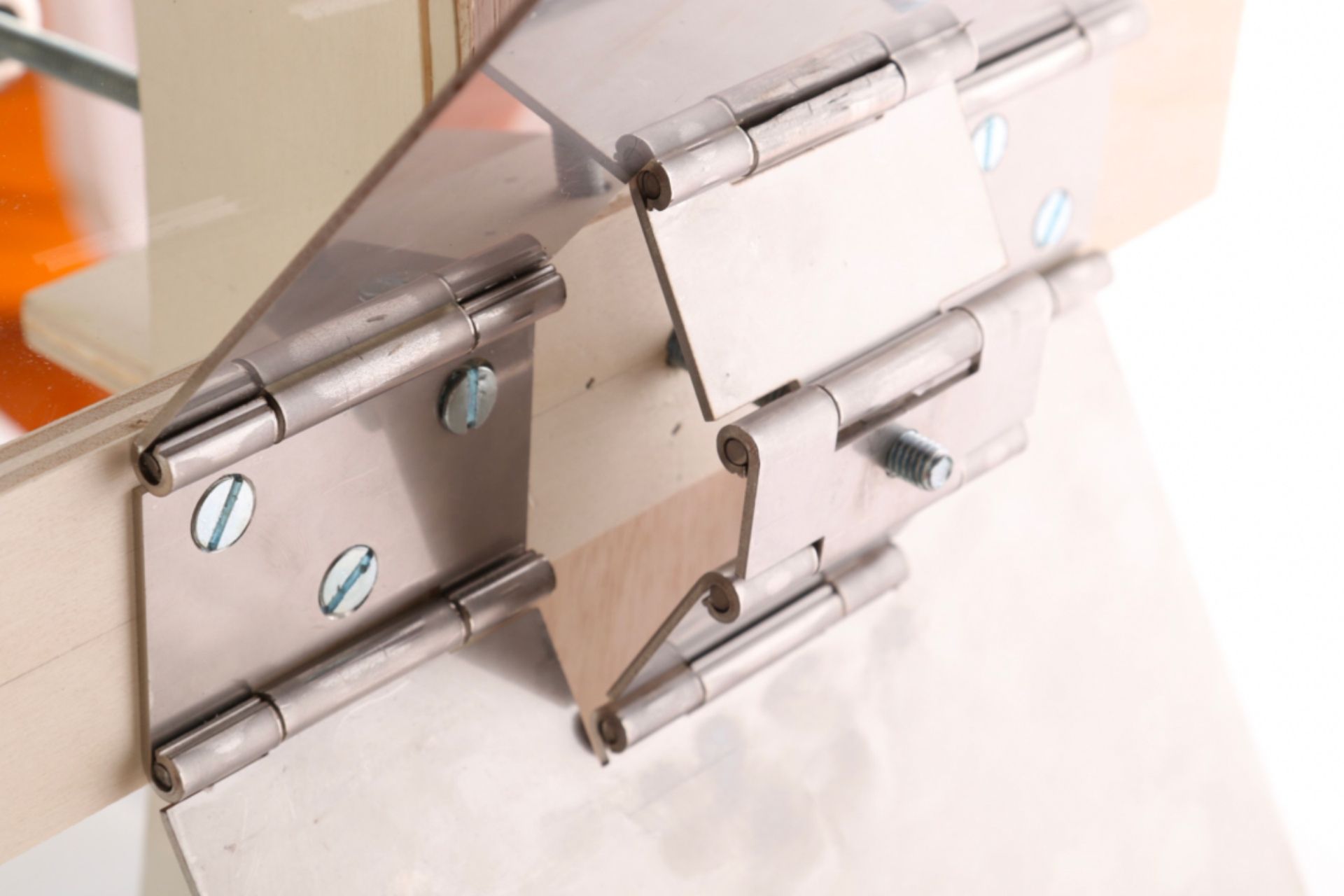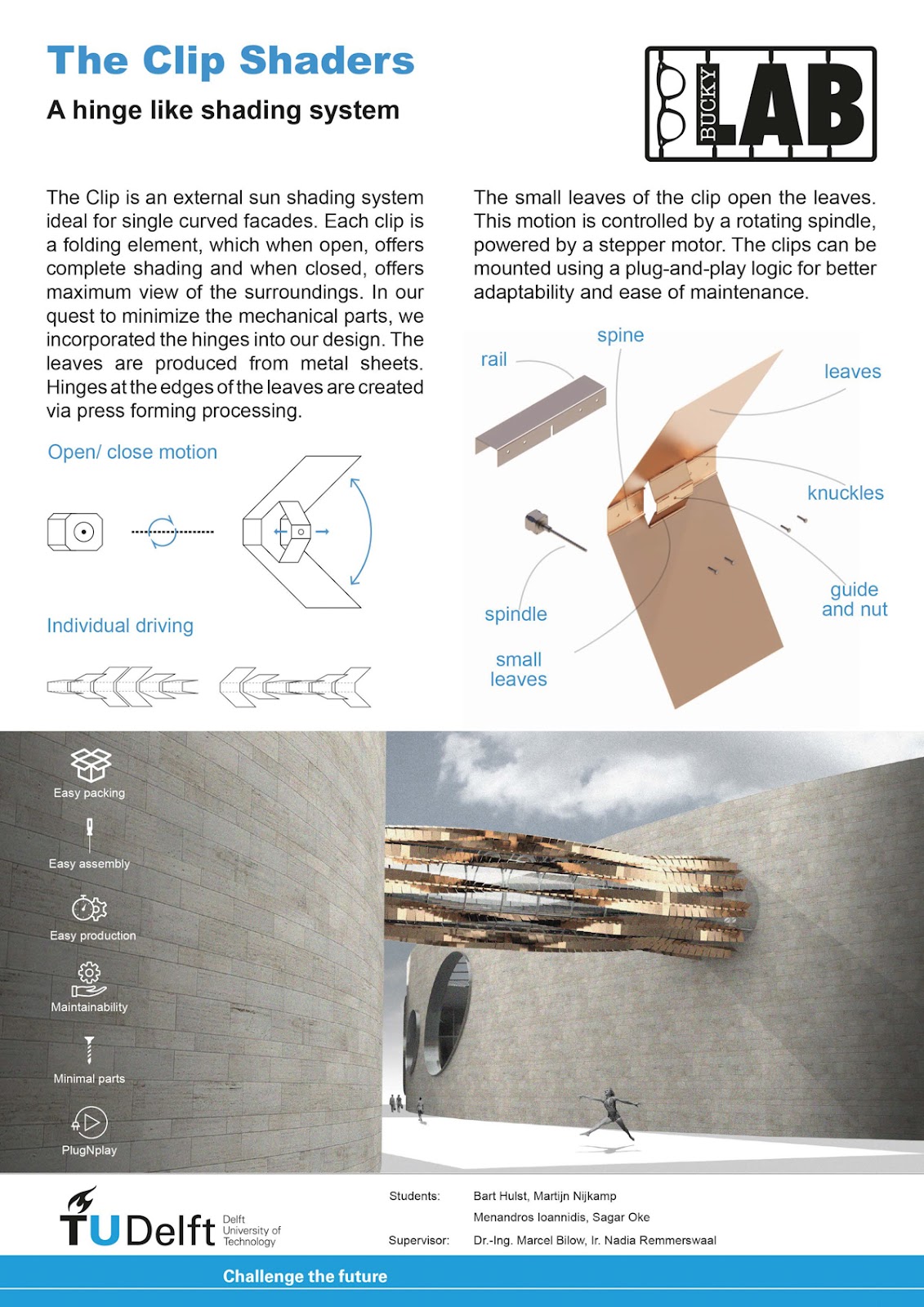A shading system made of hinges? It wasn’t the plan of the students from the TU Delft Faculty of Architecture, but it turned out to be the perfect solution for their project: ‘Although we hadn’t deliberately set out to use the hinge in a smart way – it seemed more of a necessity – we came to the conclusion afterwards that the hinge offered both mobility and stability for the final product.’ The result? A ten! And a very impressive innovative design. Meet ‘The Clip Shaders’!
BOSCH Hinges: for the future
At BOSCH Hinges, we place great value on the future. Therefore, we are proud sponsors of sustainable initiatives and cooperate with various educational institutions. After we recently developed a hinge solution for a unique hydrogen car for the Green Team at the University of Twente, architecture students at TU Delft contacted us for a very special shading system: made of hinges.
Meet ‘The Clip Shaders’ – a hinge like shading system
The Clip is an exterior shading system that is ideal for single-curved facades. Each clip is a folding element, providing full sun protection when open and maximum visibility when closed. The concept was designed by students from TU Delft’s Bucky Lab, as part of the Building Technology master’s program. This master’s course at the Faculty of Architecture focused this year on the design of flexible, dynamic shading systems for irregularly shaped glass facades. The challenge it posed to its students? Develop and build an innovative shading solution, which provides a comfortable indoor climate in summer and winter and thus saves energy. An important point where the current static systems still fall short. A mission that Menandros, Sagar, Martijn and Bart did not shy away from!
“The design brief of 2021’s Bucky Lab: Design, develop and construct a public sunshade capable of shading irregularly shaped facades or windows on Earth.”
Simplicity is the key, but hinges the path
In designing the shading system, the students set a requirement that the system closed would provide at least 90% shade, while open would provide less than 10% visual distraction. In addition, the hinged system needed to be lightweight and have a fast opening sequence. Soon the students figured out that the Clip would therefore function best with as few parts and complexity as possible. Simplicity proved to be the key. Moreover, it would make the system easy to produce, (re)use and recycle. In order to keep the mechanical parts to a minimum, the students went in search of a hinged solution for their design.
“The Clip was the most promising concept out of several ideas, designed with simplicity in mind. Inspired by a simple paper clip, The Clip imitates the way it is opened and closed by a spring-like mechanism. From these simple origins, the development of the concept into a functional shading system took off.”
Need a custom hinge? Enter BOSCH Hinges
To achieve precise functionality, it was important to center the hinges around the critical points of the geometry. Therefore, the students needed a special custom hinge. It quickly became apparent that they had come to the right place for their project at BOSCH Hinges. Bart, one of the students on the project, explains: ‘After we contacted Jacco, one of the specialists at BOSCH, we were able to send him the working drawings with the dimensions of the product. He then explained the various options for the realisation of the product. Think of the choice of materials, but also of the dimensions of the attachment points. This gave us insight into the production process and the feasibility of a working product. Through this collaboration, in addition to a beautiful product, we also gained more insight into the practice. This in turn contributed to the professionalism of the product.’
“BOSCH Hinges’ advice and thinking ahead gave us insight into the production process and the feasibility of a working product. Through this collaboration, in addition to a beautiful product, we have gained more insight into the practice.”
In addition, the team was provided with a standard continuous hinge, so that the team could directly experiment with this idea themselves to gain more insight into a metal implementation of their project.
Durable and flexible design
Ultimately, the team decided to go for a hinge that could ensure that the components of the Clips could perform a dual function: both as shading geometry and as functioning hinges. This would ensure that the Clips could be produced and assembled in one location, with the entire design made of the same material, contributing to reusability. Thus, the wings were manufactured from metal sheets. The hinges at the edges of the wings were made by press forming. The small blades of the clip open the blades. The movement is controlled by a rotating spindle driven by a stepper motor. The clips can be assembled using plug-and-play logic for improved adaptability and ease of maintenance.
“The hinge is so special because it is directly integrated with our product. In addition, it provides both mobility and stability.”
The hinge being manufactured at BOSCH Hinges’ jobshop
Perfect integration with the design
Bart: ‘In our opinion, the hinge is so special because it is directly integrated with our product. There were very few other options that could have done the product so much justice. Although we hadn’t purposely set out to use the hinge smartly – it seemed more of a necessity – in retrospect we came to the conclusion that the hinge provided both mobility and stability for the final product.’

‘For the version that the students have now created, we used stainless steel RVS-304 because it is the easiest to process and readily available, which contributes to the simplicity of the production as the students envisioned it,’ says Jacco of BOSCH Hinges. ‘Of course, when The Clip is used for a particular building, one could use a different material if it is a better fit.’ For example, according to the students, aluminum would also be a possibility, to make the product even lighter.
And the students?
They achieved a 10 for their project!
Congratulations for this outstanding performance and the pleasant cooperation.
“A special thanks goes to Bosch Hinges B.V., for their extraordinary generosity in making the production of ‘the Clip’ a reality, as well as their extraordinary enthusiasm during the design process.”
More about the projects at TU Delft’s Bucky Lab?
View the website of the master course at TU Delft here!

















